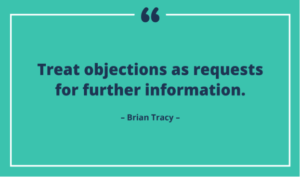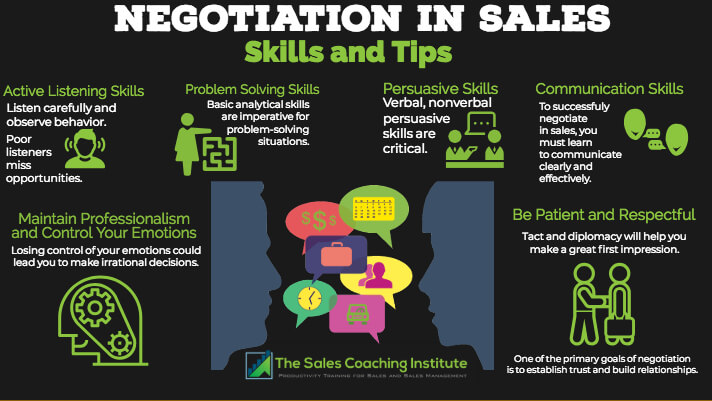What You Need To Know About Selling to Large Companies
Continue reading “5 Truths About Selling to Large Companies”
Continue reading “5 Truths About Selling to Large Companies”

When handling customer objections, sales professionals must learn to shift their mindset from treating a “no” answer to a sales proposal as a personal rejection to recognizing it as an opportunity to learn more about the company and the challenges it faces. Reframing your mindset in this way is crucial to your success as a sales professional as it allows you to dig deeper into your customer’s mind in order to reveal positive alternatives and solutions. Continue reading “Handling Customer Objections in Sales”
Negotiating in sales is one of the most fundamental aspects of selling. Every sales professional will spend the majority of his/her career negotiating with either their customers, employees, and even themselves. Getting other people to see things from your perspective while listening to their point of view in an equally respective manner is a key aspect of acquiring new customers, retaining profit, and building meaningful relationships in business. It can also be the most frustrating. Negotiation is an art form that requires working with someone or groups with different views in order to create a mutually beneficial agreement.
Read Our Free White Paper: 8 Critical Negotiation Skills to Kill Your Sales Quota
Negotiators should think about how to develop strategies that will help both sides to get more of what they want. Don’t look at negotiation in sales as a competitive, win-lose battle where you inevitably cave into bad deals in order to avoid conflict. When negotiating in sales, you can achieve better results by keeping these 4 key principles in mind:

Remember that your counterparts are human beings and not just another sale. They have their own feelings, opinions, values, and backgrounds that influence what they say during the negotiation.
To solve this problem, imagine the situation from their perspective. When you are negotiating with someone who is firm in their position, ask them how things are working out for them. This allows you to gauge their point of view more clearly and can help you avoid resorting to blaming tactics during the negotiation process.
Often times negotiations begin with both parties coming out strong with their positions which leads to a deadlock. This can be difficult to get out of because you are left with little room to negotiate. A better stance to take would be to ask questions about their interests and what motivates their position. You can ask them why a particular stance is important to them or probe them for more details.
Prioritizing interests gives you a chance to share your own which can open up more opportunities to explore each other’s problems allowing you to create a solution that benefits both parties.
Allow yourself and your counterpart to be honest with any strong emotions you feel during the negotiation process. Give ample time for them to honestly speak their mind. Emotions get in the way of looking at the problem for what it is. Taking turns to express your feelings without interrupting lets you listen better to what is being said and can prevent arguments from getting out of hand.
Expressing appreciation can help to open up your counterparts during the negotiation process. Understanding where others are coming from and highlighting key points in what they are trying to communicate shows that you are listening. It also shows that you respect what they are saying and where they are coming from.
It is imperative when negotiating in sales that you remain calm and relaxed. You want to inspire their emotions and control yours. Remember to think about objectives over objections. Over time the experience you gain from negotiating in sales will allow you to incorporate a unique style and flair but keep these 4 key principles of negotiation in mind on your next deal!

Do you like what you just read? Visit our resource center and download any or all of our 17 Executive Sales White Papers to help improve your sales skills training and build a successful sales career.

Sales professionals can learn a lot from sales scenes in movies. Hollywood may seem like an odd place to look for inspiration but rest assured, there are plenty of invaluable sales lessons to be learned from Hollywood’s cult classics. Learning how to handle customer objections during sales calls, dealing with difficult clients, or refining your sales strategy, can improve your selling skills. When it comes to handling customer objections, these key sales lessons from Tommy Boy can teach sales professionals a thing or two about how to effectively deal with customers’ concerns. Learn how to navigate the world of sales by taking a cue from these two classic sales scenes in Tommy Boy.
There are key sales lessons from Tommy Boy that teach you how NOT to prepare for sales meetings. Tommy (played by Chris Farley) prepares for the upcoming sales presentation meetings by frantically pacing to overcome his nerves as Richard (played by David Spade) tries to prepare him with some classic sales advice: “We don’t take no for an answer.” What follows is a hilarious montage of sales meetings with Tommy bailing out of every sales meeting after getting rejected without even learning how to handle customer objections.
The fundamental message here is that with every sales meeting will come objections of all kinds. It’s important to be resilient with how you overcome rejections in sales. Pay attention to your clients’ reasonings and objections. Adjust your responses accordingly and treat every objection as a chance to ask more questions about their specific problems. A good sales tip is to know your product or service like the back of your hand.
Sales professionals must also learn to read their customers personality and adjust their sales presentation accordingly. One way to do this is to ask open-ended questions that reveal their specific pain points and problems. Pay close attention to the nature of their language (and body language), when they answer your open-ended questions. Adjust your approach accordingly to match their personality to improve your chances of closing the sale.
Both Richard and Tommy fail to speak the customers’ language in this specific scene. Richard relies too heavily on the technical aspects of the product or service and inevitably turns the customer off. Tommy, on the other hand, is too informal with his approach and unavoidably ends up ruining the sale.
Now let’s look at how Tommy Boy effectively handles customer objections. In a critical scene of the movie, Tommy closes his first sale with a customer by utilizing open-ended questions and asks, “Why would someone put a guarantee on the box”? This strategy moves the conversation forward and keeps the customer engaged and curious.
A key sales lesson from Tommy Boy is to take advantage of the belly-to-belly you have with customers. Tommy was able to effectively deliver a convincing argument as to why his product was superior. He was able to close this deal by handling the customers’ objections with relevant anecdotes and interesting examples. Tommy’s argument was predicated on the fact that a “guaranteed label” on a box does not always correlate with a quality product. Tommy learns how to handle customer objections and ultimately ends up closing his first sale on the road and goes on t save his father’s company.
If you enjoyed these key sales lessons from Tommy Boy and would like to learn more about how to handle your customers’ objections with The Sales Coaching Institutes One-on-One Sales Coaching program or our Professional Sales Training services.